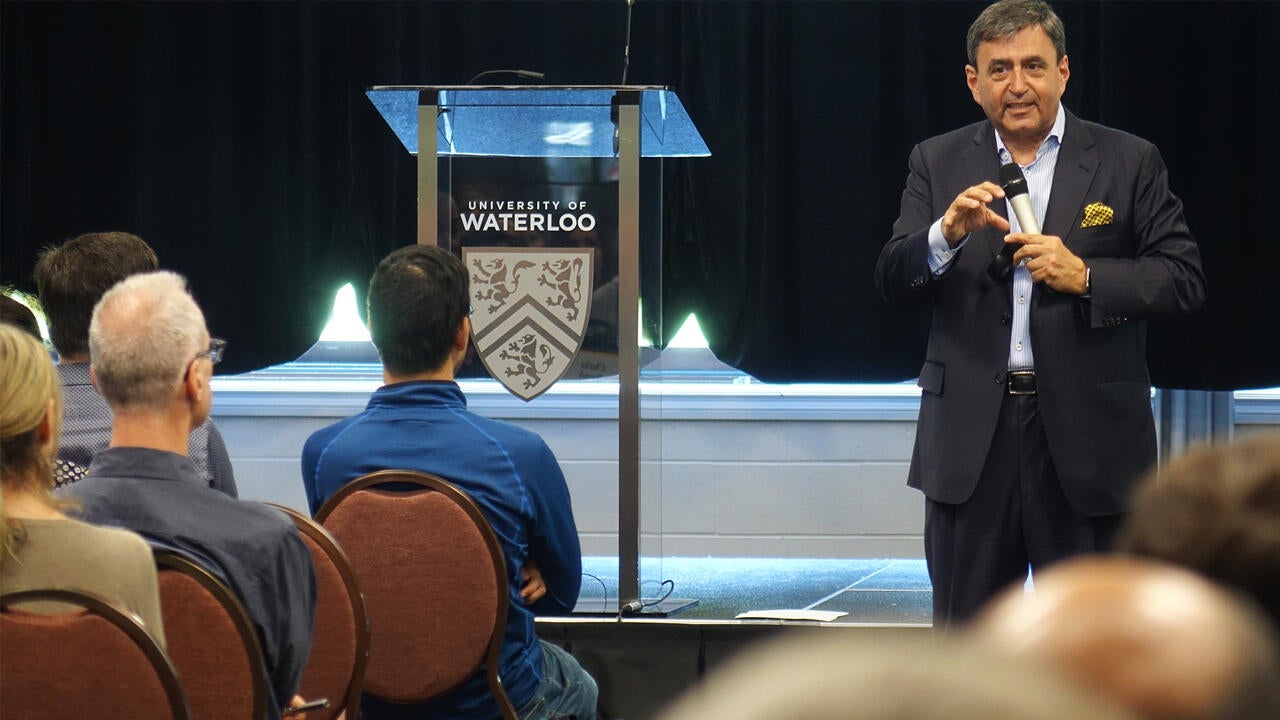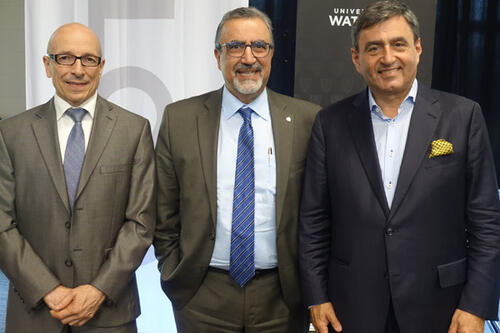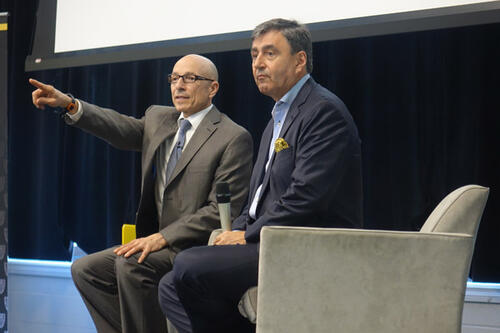
Harvard Professor visits Waterloo for Presidential Lecture
From "the sage on the stage" to "the guide from the side," Eric Mazur talked learning that sticks.

From "the sage on the stage" to "the guide from the side," Eric Mazur talked learning that sticks.
By Brandon Sweet Daily BulletinOn Friday, June 8 the University of Waterloo welcomed Harvard physics professor and thought leader Eric Mazur for a Presidential Lecture.
Mazur is the Balkanski Professor of Physics and Applied Physics and Dean of Applied Physics at Harvard University. Aside from his work as a prominent physicist, he is widely known for his work on Peer Instruction, an interactive teaching method aimed at engaging students in the classroom and beyond.
Mazur's Presidential Lecture, entitled "Innovative Education to Educate Innovators," was an interactive dialogue on innovation in teaching and learning based on his experiences as a new physics professor at Harvard.

Associate Vice-President, Academic Mario Coniglio (left), President and Vice-Chancellor Feridun Hamdullahpur (middle), and Harvard Professor Eric Mazur (right) posing for a picture following the lecture.
"Thinking back, I realized I never asked myself the question 'how am I going to teach?' Which is kind of strange because that's the first question you should ask yourself," Mazur said of his early teaching days. He highlighted the long history of the university lecture, a style of education nearly as old as the academy itself, going back to the Middle Ages, with robed educators standing before rows of students.
"Notice that we still wear these funny clothes at graduation just to remind ourselves we are steeped in medieval traditions," he said.
The unquestioned assumption about education, Mazur argued, is that it is a transfer of information. But is that all it is? As he considered the inability of his students to apply the concepts learned in his introductory physics classes to real-world problems rather than ersatz theoretical examples, Mazur said he came to understand that it was the assimilation of that information, and not just its transfer, that truly mattered.
Lectures given in auditoriums, long the standard model of knowledge transfer, were like theatrical performances that did not allow students the space to reflect on what they had just learned because they were essentially passive spectators and not participants in the learning experience.
"You need to connect that education to things you already know," Mazur explained. "Extract the mental models that permit you to apply what you have learned in a new context. That’s the key."
Mazur found that by creating spaces for dialogue and discussion among students, learning outcomes could be greatly improved. This was the thinking behind Peer Instruction. He would introduce his students to a concept, provide an example problem and then poll his class, inviting them to discuss their answers with one another and through dialogue eventually arrive at the correct answer.

Associate Vice-President, Academic Mario Coniglio (left) points out an audience question to Harvard Professor Eric Mazur (right), who held an audience Q&A after his lecture.
“It is active learning, not passive learning,” Mazur said. “It’s impossible to sleep in my class because a neighbour will talk to you.”
Mazur illustrated this by inviting the audience at Fed Hall to engage in just such a dialogue after a quick physics lesson about thermal expansion. Soon he had faculty members, students, and staff members turning around in their chairs and comparing answers with one another until everybody in the room ‘got it.’ Mazur said, “it’s like the old saying, ‘you can forget facts, but you can’t forget understanding.’”

Read more
Here are the people and events behind some of this year’s most compelling Waterloo stories

Read more
It Started in Waterloo: An Astronaut's Journey into the Universe of Innovation, narrated by Chris Hadfield, highlights the University of Waterloo’s role in igniting innovation within the region and beyond.

Read more
Waterloo researchers have developed a new quantum computing approach that brings science closer to simulating the early universe
The University of Waterloo acknowledges that much of our work takes place on the traditional territory of the Neutral, Anishinaabeg, and Haudenosaunee peoples. Our main campus is situated on the Haldimand Tract, the land granted to the Six Nations that includes six miles on each side of the Grand River. Our active work toward reconciliation takes place across our campuses through research, learning, teaching, and community building, and is co-ordinated within the Office of Indigenous Relations.